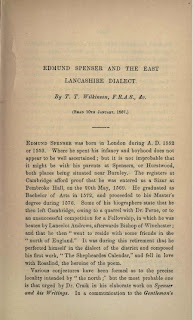You should never, so they say,
meet your heroes. Maybe you should not look to deeply into their backgrounds
either. Take the example of Edmund Spenser. I started to read Spenser years
ago; at first I found him hard going, then I got attuned to him and I was
converted. I especially liked the minor works, but of course The Fairie
Queen stands out as an astonishing piece of work. I expected him to have
been a hit at the court of Queen Elizabeth (The Fairie Queen is
allegorical Elizabethan propaganda, after all), and when I started to read a
little deeper, it was as I thought – born in London, went to Cambridge, life at
court, buried in Poet’s Corner, Westminster Abbey. Then I looked deeper still.
 |
| Edmund Spenser |
He was born in about 1552; his father, John, was a journeyman cloth maker who had moved to London from Lancashire. The name Spenser (with the ‘s’ – rather than Spencer) is common around Burnley and Pendle – as are the first names Edmund or Laurence – the registers of Baptism for Burnley from 1564 to 1703 have twenty-nine entries for either Edmund or Laurence Spenser. A Laurence Spenser was buried at Newchurch in Pendle in 1584, and may well have been the poet’s grandfather. In and around Hurstwood, (and adjoining Extwistle and Briercliffe), the Spenser family had long held property, and John was a member of this branch of this family.
 |
| Spenser's cottage, Hurstwood, nr Burnley |
The young Edmund attended Merchant Taylors’ school, before he became a sizar at Pembroke Hall (now College), Cambridge. That he was a sizar indicates the family was not well off, as he would have worked in the college kitchens and served at table in return for reduced fees, but he also received money on several occasions from a charitable bequest from Robert Nowell of Read, near Burnley. Robert Nowell was the brother of Alexander Nowell, Dean of St Paul’s, London, and was the great-uncle of Roger Nowell, the magistrate at Read who had prosecuted the Pendle witches in 1612. At Cambridge he made several important acquaintances, but after graduation Lancelot Andrews, later Bishop of Winchester, beat him for a Fellowship and so he ‘…went to reside with some friends in the North of England’. These Friends in the North were undoubtedly members of his extended family, and local tradition places him at Spenser’s Cottage in Hurstwood in 1576-77.
 |
| Edmund Spenser - The Shepheards Calender 1597 edition - Title Page |
Internal evidence in The Shepheards Calender (1579) points to a strong Lancashire connection, and he may well have written the early parts of it at this time. The heroine, Rosalind, has been identified as Rose Dyneley from Downham, although other Dyneleys lived in Pendle; Menaleas is an anagram of Asmenal[l], a local family name now spelled Aspinall. Rose, it seems, spurned Spenser’s love, preferring a local yeoman instead, which broke Spenser’s heart.
 |
| T T Wilkinson - Edmund Spenser and the East Lancashire Dialect 1867 |
In a speech to the Historic Society of Lancashire on January 10th 1867, T T Wilkinson listed forty-five words taken from East Lancashire dialect, (which he delightfully calls Folkspeak – “ ... more appropriate and comprehensive than ‘dialect’”), that appear in The Shepheards Calender, many of which Wilkinson says were still used in Pendle in the 1860s, and many of which are still used in 2012 (I know, as I use some of them myself). He notes, for instance, that Extwistle (‘the boundary of the oaks’) and Briercliffe (‘steep with briars’), both close by Hurstwood, appear in the February eclogue, in the old man’s story of the Oak and the Briar.
 |
| Walter Crane illustration to February - The Shepheards Calender |
Wilkinson also notes that the East Lancashire folkspeak is closely allied to Lowland Scots, with many identical words and phrases being shared and derived from common sources in Danish and Norse, and he mentions the noticeable differences between the East Lancs and South Lancs dialects. A transcript was published in the Transactions of the Historic Society of Lancashire and Cheshire, New Series Volume VII, 1867.
So, we’ve got a lovely local connection to one of the great Elizabethan poets. Brilliant.
 |
| Edmund Spenser - Title Page A View of the State of Ireland |
Except Spenser went on to write, in 1596, A View of the Present State of Ireland, which is one of the most hateful pieces of bile I have ever had the misfortune to read, (and that includes Hitler’s Mein Kampf). It takes the form of a dialogue between Irenius and Eudoxus, with the ‘expert’ Irenius explaining the reasons for the degeneracy of the Irish to Eudoxus - the inferiority of their culture, society, language and customs, and how the English in Ireland should employ a scorched earth policy, to starve the Irish people into submission. It is a devastatingly ironic anticipation of Swift’s satirical Modest Proposal of 1729, and an insult compounded by the actual Great Famine in 1845-52. Spenser’s View was not published during his lifetime, it was not printed until 1633 – it is a pity it was ever printed at all. In 1599, Edmund Spenser died in London – ‘for lack of bread’ – in his late forties. I admire his work, his skill, his learning and his wit. I am glad not to have had the opportunity of meeting him.

No comments:
Post a Comment